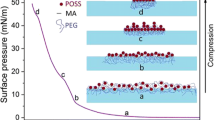Abstract
The surface pressure (Π) vs surface concentration (Γs) curves of the hydrogen-bonded polymer blend poly(vinylacetate)+ poly(4-hydro-xystyrene) (PVAc+P4HS) have been measured at 25 °C onto a water subphase at pH=2.0. While PVAc forms extended monolayers, and the free surface of water is found to be a good solvent for it, P4HS forms compressed monolayers, and the surface is a near Θ-type solvent for it. PVAc and P4HS form miscible non-ideal monolayers until near the collapse pressure through the whole concentration range. The composition dependence of the Π–Γs curves is rather complex. Contrary to what might be expected, the addition of PVAc to the blend does not reduce the rigidity of the monolayer until its weight fraction is larger than 0.5. The compressibility data of the P4HS-rich monolayers suggest the existence of a second maximum at high surface coverages, a result already observed in some polysiloxanes.
Similar content being viewed by others
Author information
Authors and Affiliations
Additional information
Received: 11 March 1998 Accepted: 7 May 1998
Rights and permissions
About this article
Cite this article
Monroy, F., Esquinas, M., Ortega, F. et al. Monolayers of hydrogen-bonded polymer blends at the air–water interface: poly(vinylacetate)+poly (4-hydroxystyrene). Colloid Polym Sci 276, 960–967 (1998). https://doi.org/10.1007/s003960050334
Issue Date:
DOI: https://doi.org/10.1007/s003960050334




